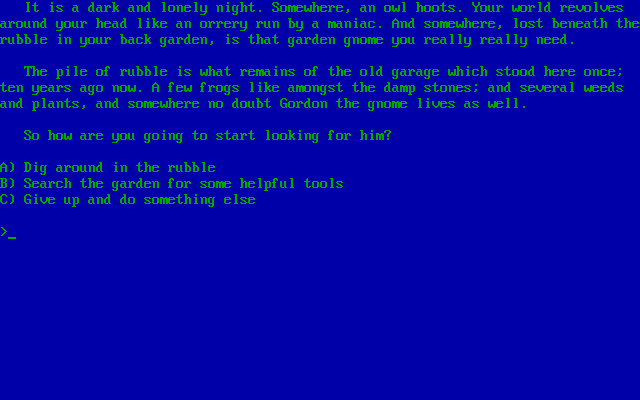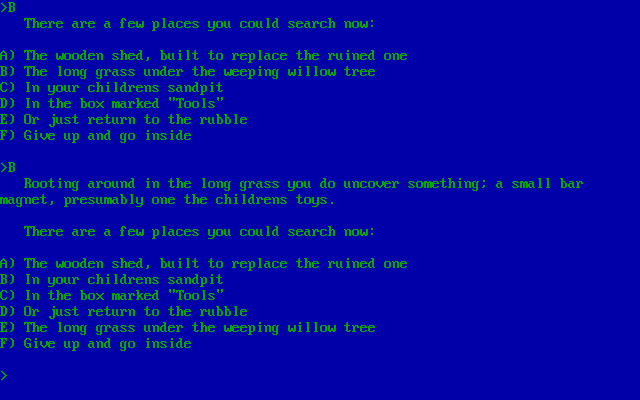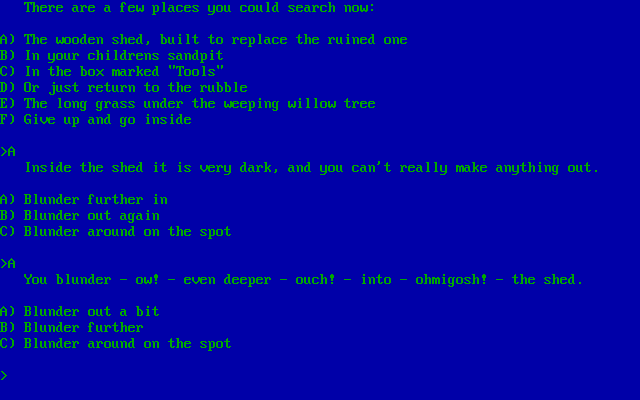Retro Replay Review
Gameplay
Adventure Book’s core appeal lies in its straightforward, choice-driven gameplay. Each demonstration title—most notably Gnomic and Aliens!—uses a simple letter‐selection interface. Players read a passage of text and then pick the letter corresponding to their desired action, be it exploring a garden shed for a hidden gnome or attempting to crack an alien cipher. This familiar choose‐your‐own‐adventure mechanic makes the learning curve virtually nonexistent for newcomers.
(HEY YOU!! We hope you enjoy! We try not to run ads. So basically, this is a very expensive hobby running this site. Please consider joining us for updates, forums, and more. Network w/ us to make some cash or friends while retro gaming, and you can win some free retro games for posting. Okay, carry on 👍)
Beyond letter choices, Adventure Book also introduces a rudimentary inventory system. To use an item you’ve picked up, you type its name exactly as it appears in your list. Though this may feel dated compared to modern point‐and‐click or menu‐based inventories, it reinforces precision and attention to detail—qualities that budding programmers will appreciate when they start modifying or extending the engine themselves.
What truly sets Adventure Book apart is its dual function as both a playable suite and a teaching tool. While Gnomic and Aliens! are entertaining in their own right, the underlying hyperfiction engine is laid bare for experimentation. You can load the source definitions, tweak branching logic, or even craft your own mini‐adventures within minutes. For anyone curious about interactive storytelling, the hands‐on feedback loop is immensely satisfying.
Graphics
Adventure Book is unapologetically text‐only, foregoing illustrations or sound in favor of pure narrative. While some players might miss visual flourishes, the lack of graphics keeps you rooted in imagination—much like sitting around a campfire and weaving a story together. The stark presentation also means the entire suite runs smoothly on virtually any hardware, from a vintage PC to a modern laptop.
The user interface leans on clean, monospaced fonts that echo classic terminal aesthetics. Text is clearly delineated, with player options presented in bold or brackets so you never lose track of your choices. Though there’s no scrolling background or animated transitions, the crisp typography and simple page breaks make each decision point feel distinct and well‐paced.
For aspiring designers, the text‐only approach is liberating: you focus on narrative structure and game logic rather than image assets. When you dive into the Adventure Book engine, you’ll find that formatting commands and branching tags are easy to grasp and modify. In this way, the “graphics” serve an even greater purpose: inviting you to become the artist behind your own interactive tales.
Story
Gnomic, the flagship demo, strikes a playful balance between humor and puzzle‐solving. You’re on a quest to find a long‐lost garden gnome in an overgrown backyard. Each decision—sneaking past a suspicious cat, rummaging through rusty tools, or using a rope to climb a shed—can lead to success, hilariously disastrous traps, or entirely unexpected twists. The name Gnomic is a clever double entendre, hinting both at the pursuit of arcane knowledge and the literal retrieval of a cheeky statuette.
Aliens!, the second bundled adventure, takes you aboard a UFO holding cell with a far more urgent tone. Here, puzzle‐focused narrative reigns supreme: you intercept encrypted transmissions, decode alien symbols, and jury‐rig an escape plan before your captors return. Though brief, the story packs tension into every line of text, demonstrating the engine’s capacity for thriller and science‐fiction scenarios as easily as quaint backyard capers.
Both demos showcase branching narratives and multiple endings, inviting replay to uncover every secret path. The concise storylines are perfectly scaled for first‐time coders and players alike: just long enough to illustrate the engine’s features, yet compact enough to finish in a single sitting. Whether you’re chasing garden gnomes or fleeing extraterrestrials, Adventure Book’s tales remain engaging and full of personality.
Overall Experience
Adventure Book is less a traditional commercial release and more a toolkit wrapped around charming sample adventures. As a consumer product, it offers tremendous value: you get two polished demo games plus the full hyperfiction engine for crafting your own interactive stories. There’s no flashy marketing or bloated content—just a lean, versatile package that invites curiosity.
For budding game developers and writers, the suite is like a sandbox. You can dissect Gnomic’s branching logic, experiment with Aliens!’ inventory triggers, or start from scratch on your own narrative. The learning curve is gentle, thanks to clear documentation and human‐readable syntax. If your goal is to understand how choice‐based engines work, Adventure Book hands you the gears and lets you tinker.
As a player seeking quick, text‐driven entertainment, the demo games deliver surprisingly robust experiences. They’re concise, witty, and demonstrate the full potential of interactive fiction without overwhelming newcomers. Ultimately, Adventure Book shines brightest when you treat it as both a playable anthology and a springboard for your creative ambitions.
 Retro Replay Retro Replay gaming reviews, news, emulation, geek stuff and more!
Retro Replay Retro Replay gaming reviews, news, emulation, geek stuff and more!







Reviews
There are no reviews yet.